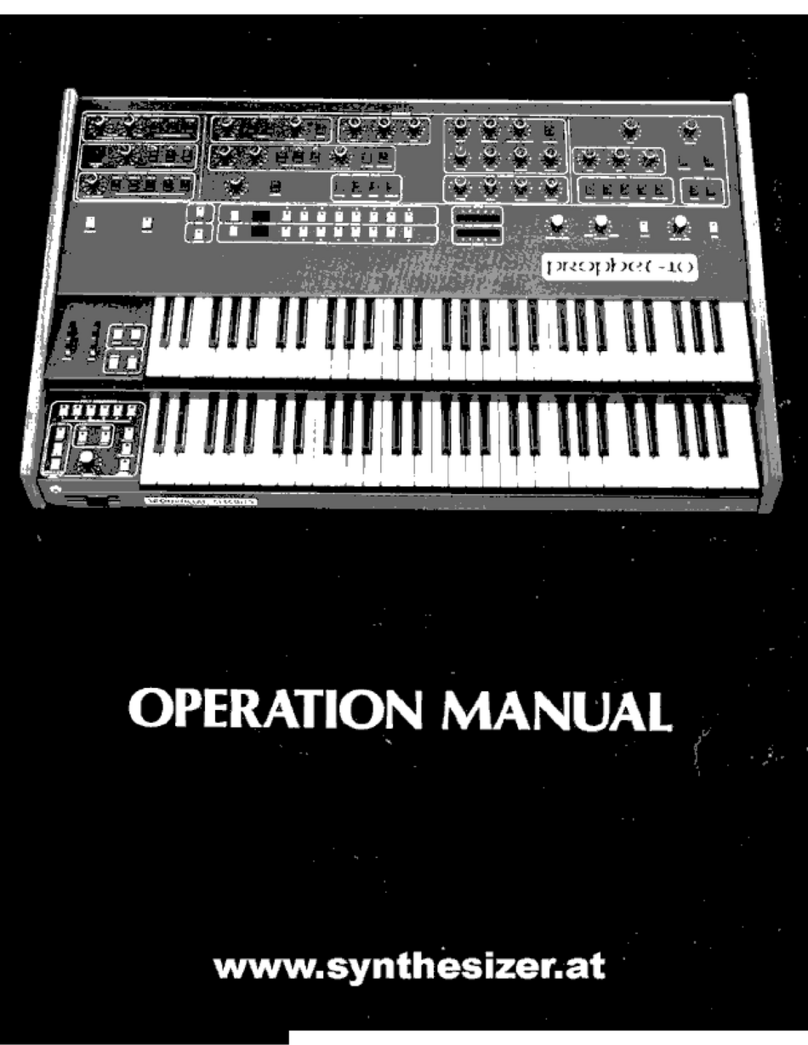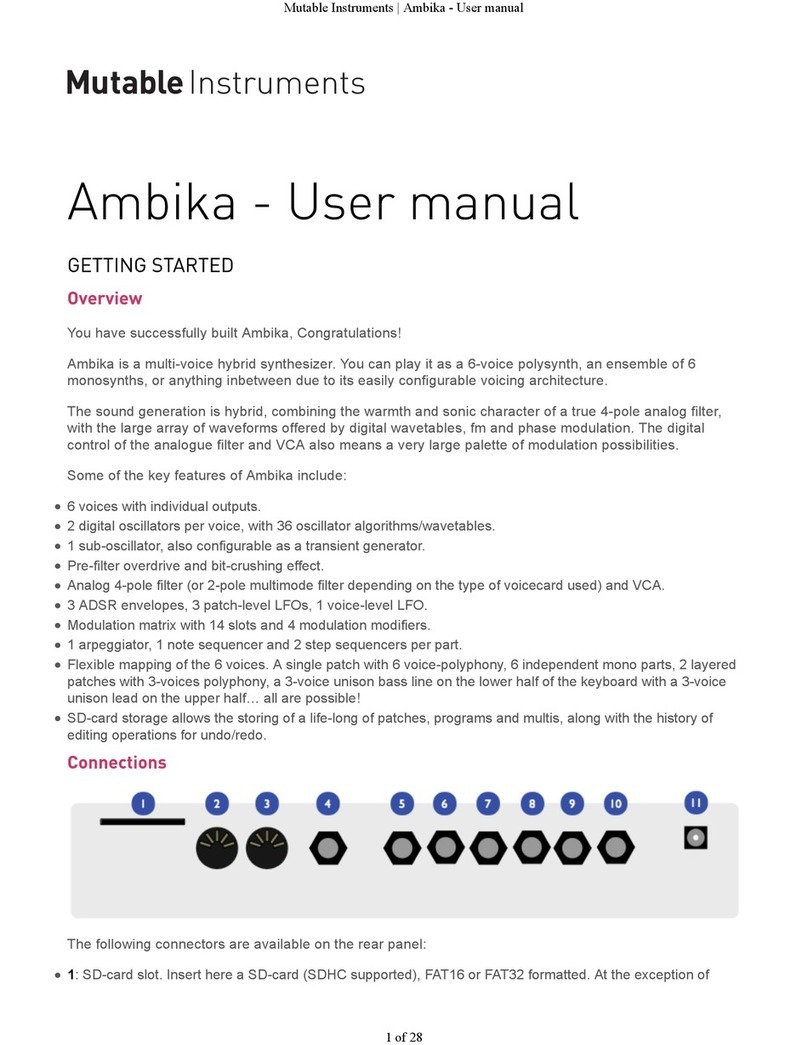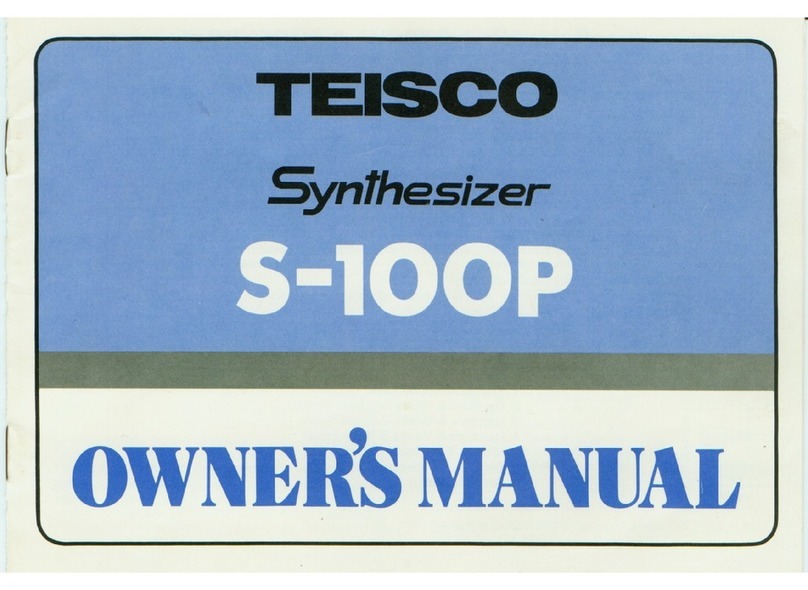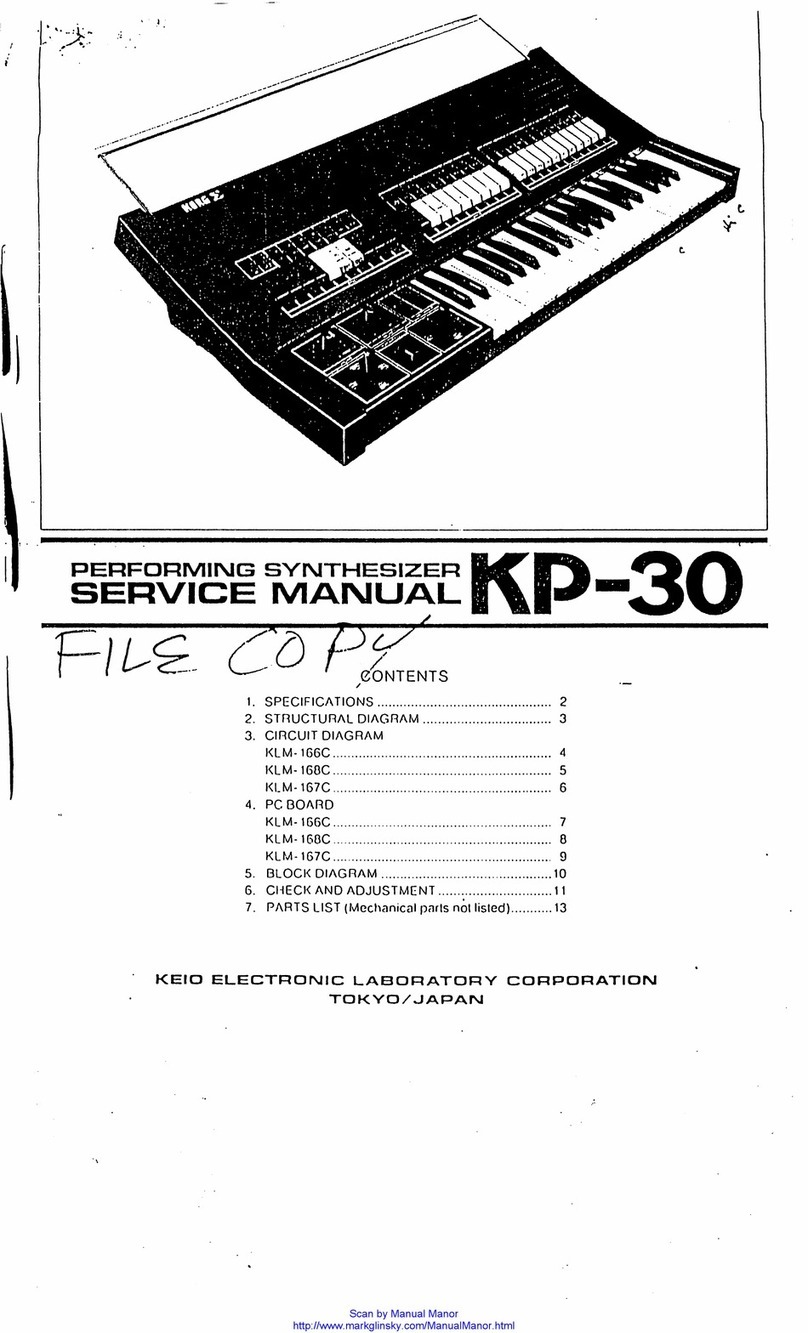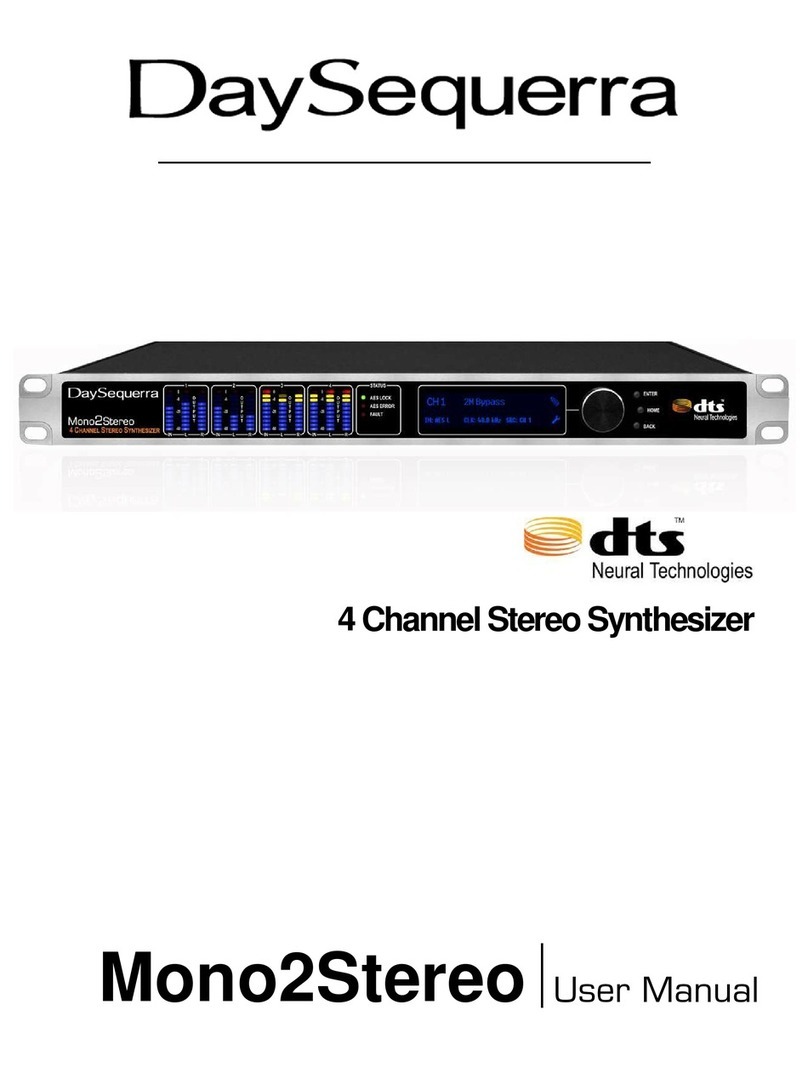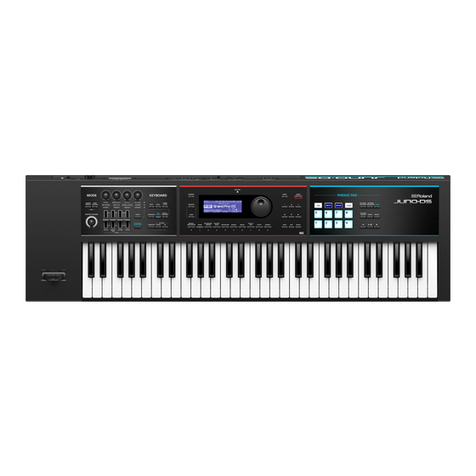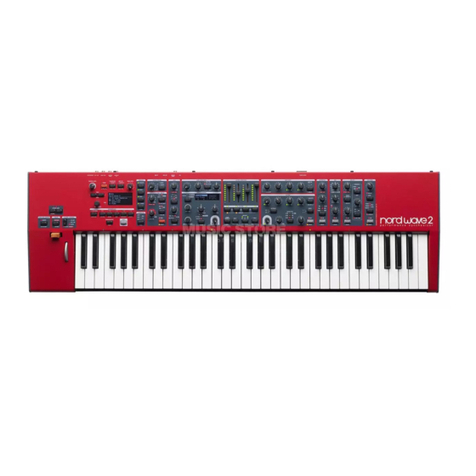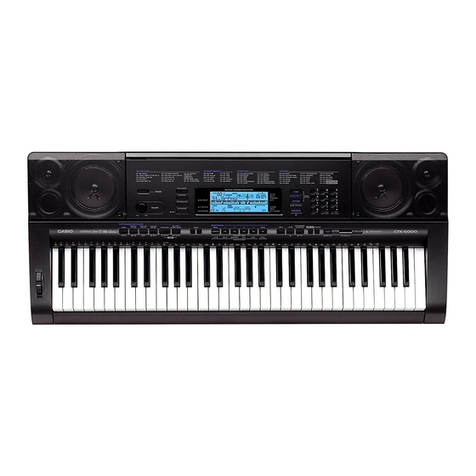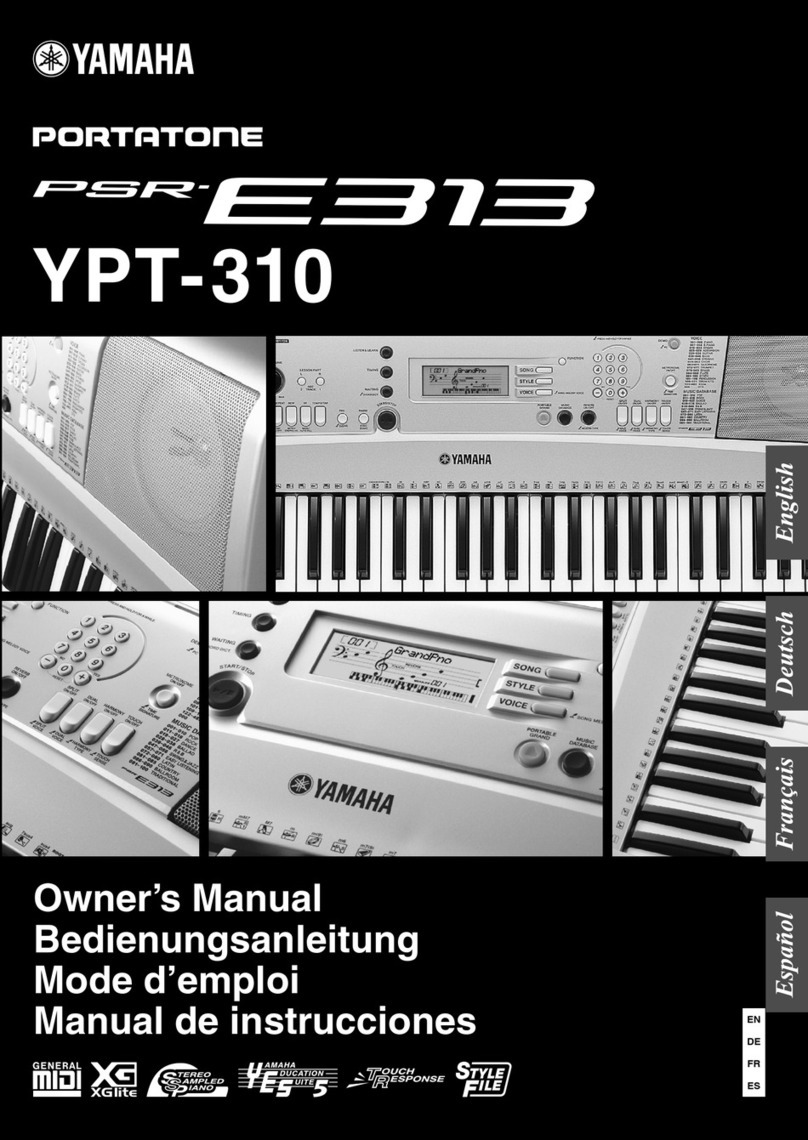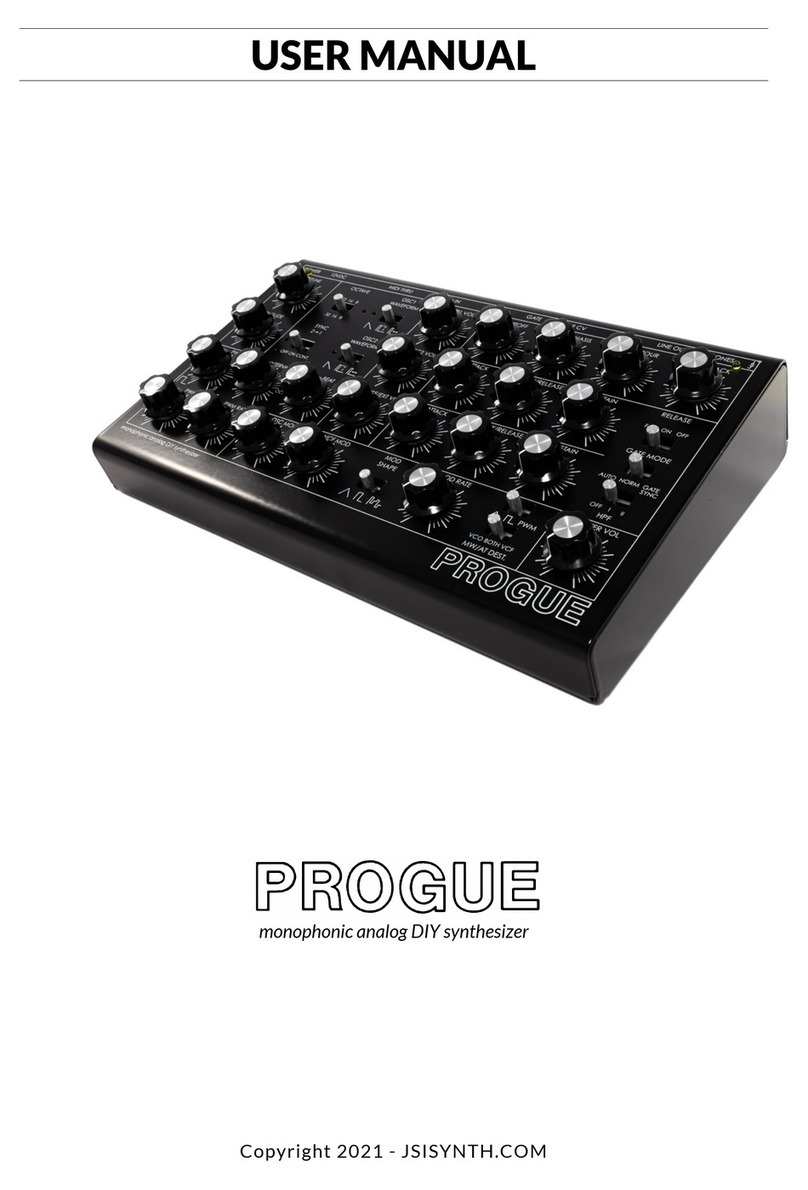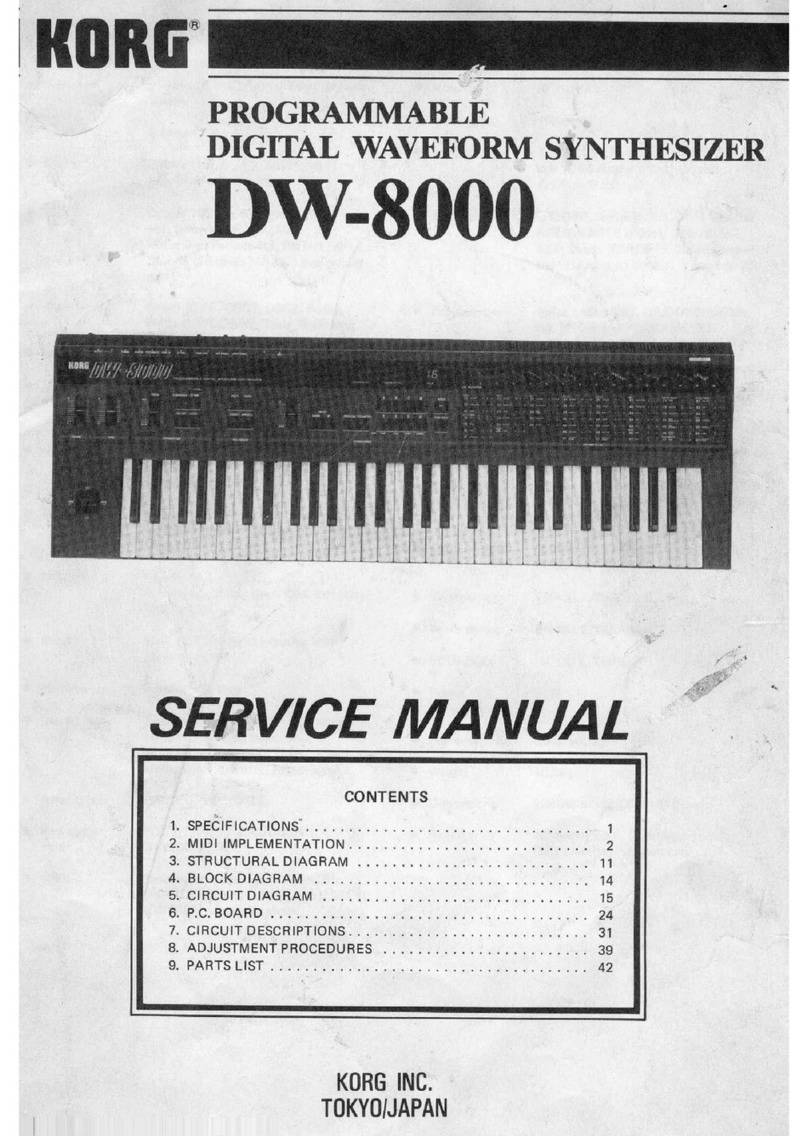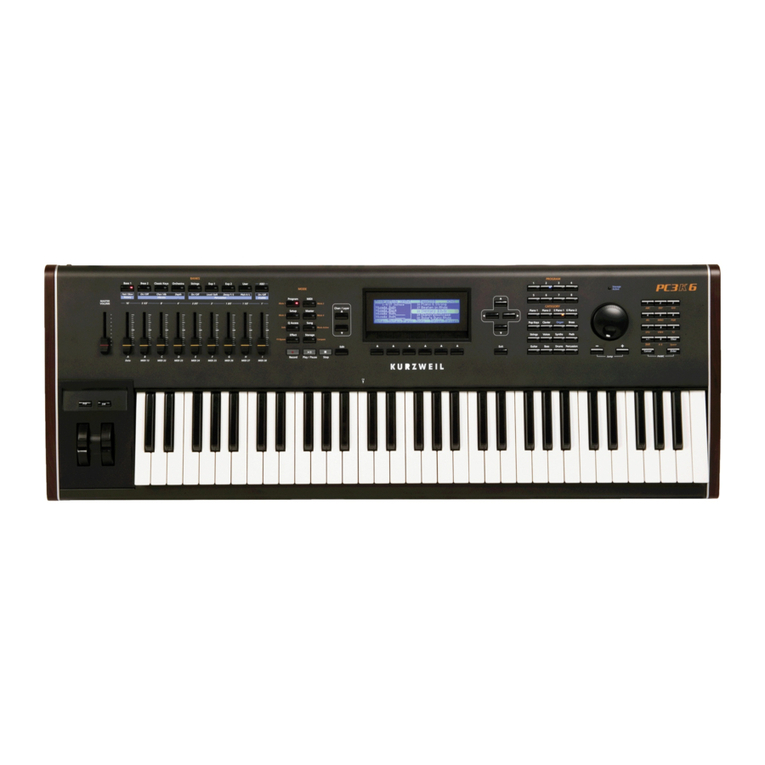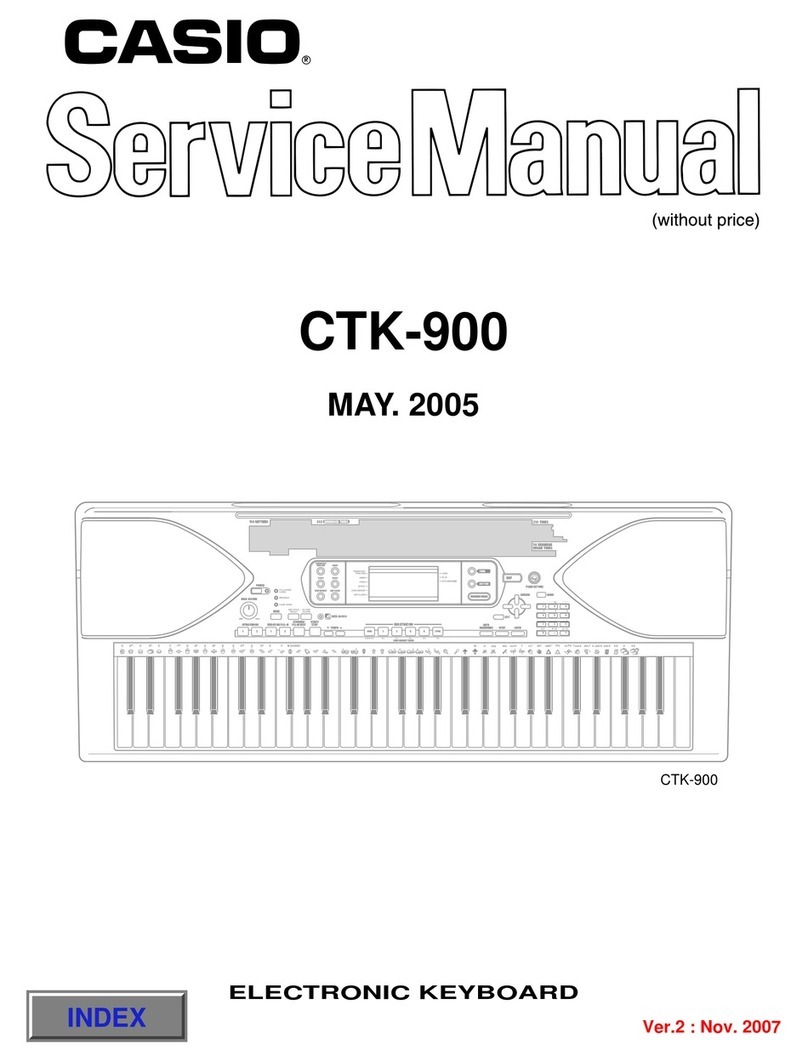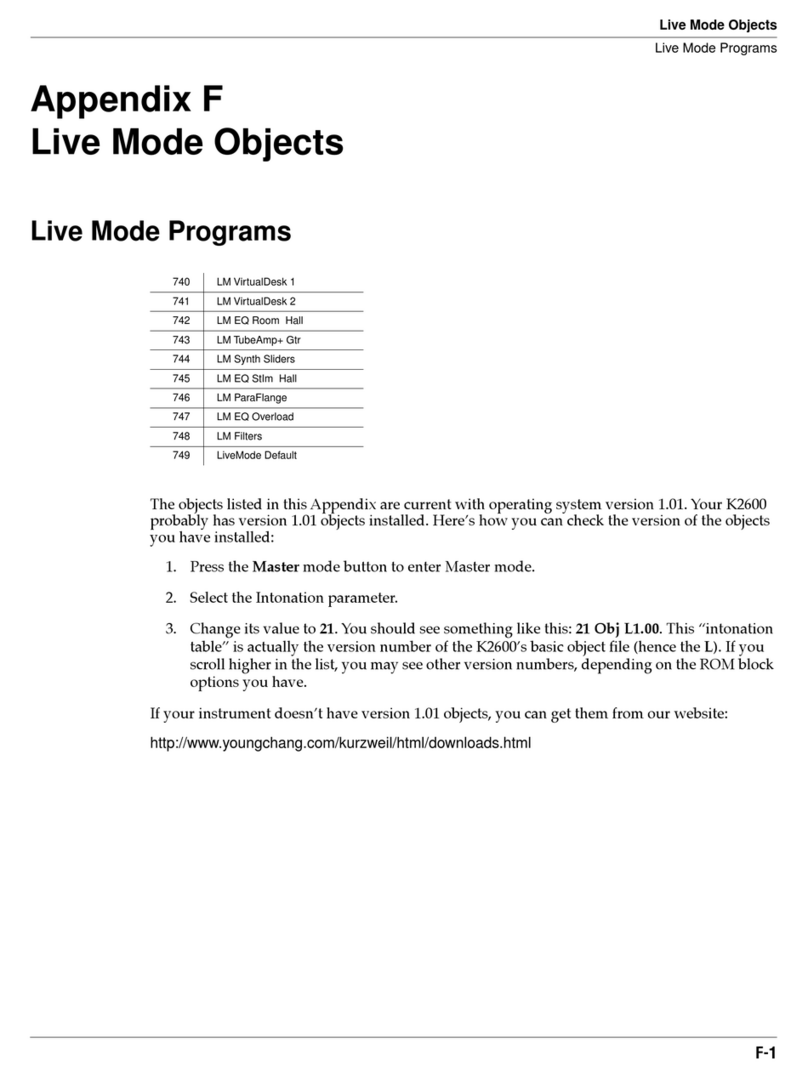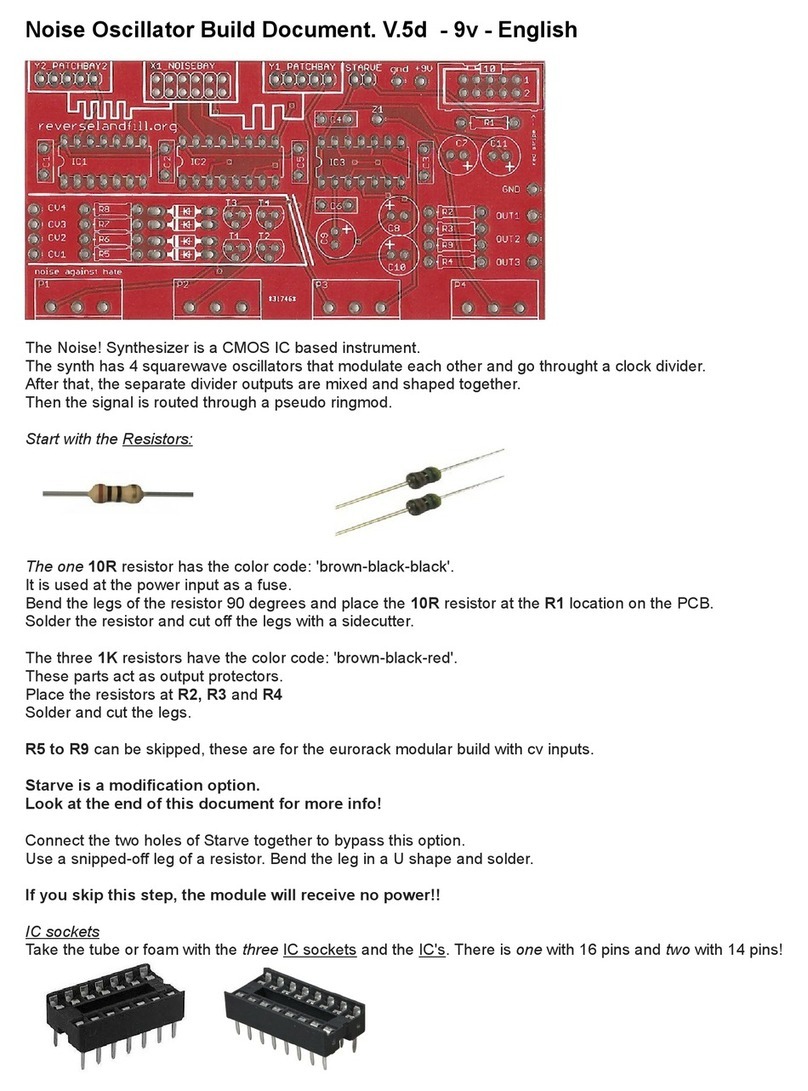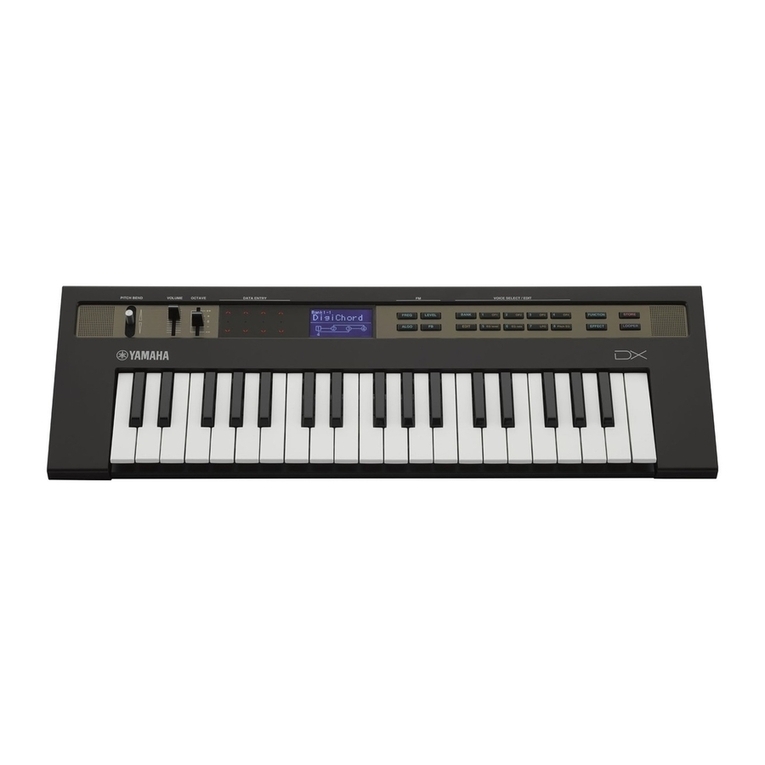SequentialSystems PRO-ONE 100 User manual


PRO-ONE
SYNTHESIZER
OPERATION MANUAL
by
Stanley
Jungleib
MODEL 100
S/N 1 and up
Sequential
Circuits,
Inc.
3051
North
1st
Street
San
Jose,
CA 95134
(408) 946-5240

About
the
Pro-One
The
Pro-One
is a
monophonic
(one-voice)
keyboard
synthesizer.
Its
principal
sound
sources
are
two
voltage-controlled
oscillators
(VCOs),
referred
to
as OSC A
and
OSC B. OSC A, OSC B,
and
a
white
noise
source
can
be
mixed
into
the
resonant
low-pass
filter
(VCF).
The
filter
modifies
the
voice
timbre
under
control
of
its
four-stage
envelope
generator.
The
filter
may
also
serve
as
a sound
source.
This
stage
is followed by a
voltage-controlled
amplifier
(VCA), which
shapes
the
voice
amplitude
also
under
control
of a
four-stage
envelope
generator.
The
,keyboard
provides
frequency
control
voltage
(K
YBD CV)
for
the
oscillators
and
filter,
and
generates
a GATE which
controls
the
envelope
generators.
In
addition
to
this
basic
voice,
the
Pro-One
has
extensive
modulation
prov1s10ns.
Three
modulation
sources
are
available:
the
filter
envelope
generator
(FILT ENV),
OSC B,
and
a
separate
low-frequency
oscillator
(LFO).
Each
can
be
mixed
and
routed
for
either
DIRECT
or
WHEEL-controlled
modulation
of
five
destinations:
OSC A
frequency
(FREQ), OSC A
pulse-width
(PW), OSC B
FREQ,
OSC B PW,
and
filter
frequency
(FILTER).
This
complement
of
analog
synthesizer
modules and
the
routings
provided
for
their
interconnection
have
been
well-proven
in
the
Pro-One's
ancestors,
the
Prophet-5
and
Prophet-10
polyphonic
synthesizers.
Besides allowing
the
synthesist
to
play up
to
five
or
ten
notes
at
one
time,
these
two
instruments
contain
microcomputers
which
program
all
the
control
settings
comprising
a sound.
The
Pro-One
is
neither
preset
nor
programmable:
you
always
"patch"
the
precise
sound you
want
with
the
knobs
and
switches
on
the
control
panel.
But
the
Pro-One
voice
itself
is
identical
to
a
single
Prophet
voice,
so
it
is
capable
of
as
much
range
and
expression.
Possessing
the
Prophet's
sound
and
all
standard
monophonic
synthesizer
features,
the
Pro-One's
own
microcomputer
makes
possible
innovations
unheard
of on a
low-
cost
synthesizer;
a
40-note
sequencer,
an
arpeggiator,
keyboard
modes
such
as
-
single-
or
multiple-
triggering,
and
the
unique
automatic
glide
feature.
Arr
audio
input
with
preamplifier
and
automatic
GATE
generator
allows
synthesizer
process-
ing of
low-level
inputs
such
as
a
microphone
or
electric
guitar.
The
audio
output
can
drive
a
monophonic
or
stereo
amplifier,
or
stereo
headphones.
Of
special
interest
to
computer
enthusiasts,
the
Pro-One
readily
interfaces
for
control
by
an
external
microcomputer.
This
manual
contains
all
the
information
you'll
need
to
fully
enjoy
this
outstanding
instrument.
CMlOO
2/81
3

Table
of
Contents
About
the
Pro-One 3
SECTION 1 BASIC OPERATION
1-0
INTRODUCTION
6
1-1
CONNECTIONS
6
1-2
PLAYING
8
1-3
KEYBOARD
CONTROLS
9
1-4
MODE
10
1-5
ARPEGGIATE
10
1-6
SEQUENCER
11
1-7
IN
CASE
OF
DIFFICULTY
12
SECTION 2 FRONT PANEL
2-0
INTRODUCTION
13
2-1
THE
VOICE
13
2-2
OSCILLATOR
A
15
2-3
OSCILLATOR
B
16
2-4
GLIDE
17
2-5 MIXER
17
2-6
FILTER
18
2-7
AMPLIFIER
20
2-8
MODULATION
20
SECTION 3 BACK PANEL
3-0
INTRODUCTION
23
3-1
AUDIO
IN
23
3-2
FILTER
CV
IN
23
3-3
GATE
OUT
24
3-4
CV
OUT
24
3-5
GATE/CLK
IN
24
3-6
CVIN
24
4
CMlOO
2/81

1
SECTION 4 ROUTINE MAINTENANCE
4-0
INTRODUCTION
25
4-1
CLEANING
25
4-2 USER TRIM
25
4-3
OPENING
28
4-4
FUSE
28
SECTION 5 SERVICE
5-0
INTRODUCTION
29
5-1
REMOVING
PCB
29
5-2
DAC
SCALE
29
5-3 TUNING
30
5-4
AMPLIFIER
BALANCE
33
5-5 KEY
CONTACTS
33
5-6 DIGITAL
INTERFACE
34
5-7
AUTHORIZED
SERVICE
CENTERS
35
SECTION 6 SELECTED BIBLIOGRAPHY
SECTION 7 FACTORY PATCHES
SECTION 8 PANEL BLANKS
y'
CMlOO
2/81 5

l
l
l
\
SECTION 1
BASIC OPERATION
1-0 INTRODUCTION
This
section
contains
instructions
for
Pro-One
set-up
and
basic
operation.
After
unpacking,
read
paragraph
1-1
and
connect
the
instrument
as
described.
To
quickly
learn
how
to
use
the
Pro-One,
read
also
paragraph
1-2. This
explains
use
of
the
factory-provided
patch
diagrams
(Section
7).
Additional
performance
information
on
the
keyboard
modes,
triggering,
the
arpeggiator,
and
the
sequencer
follows
(paragraphs
1-3
through
1-6).
The
Pro-One
synthesizer
offers
extraordinary
capabilities
for
spontaneous
control
of
pitch,
timbre,
and
loudness.
To
exploit
these
capabilities
fully,
learn
as
much
as
you
can
about
it
with
this
manual
and
the
books
listed
in
Section
6.
Additional
references
can
be
obtained
from
the
more
extensive
bibliographies
contained
in
the
sources
listed.
Thus
prepared,
you will
no
doubt
create
many
interesting
sounds.
Be
advised
that
the
best
patches
tend
to
disappear
if
not
documented.
Panel
blanks
for
this
purpose
are
provided
at
the
back
of
this
manual.
Remember
the
Pro-One
is a
sophisticated
instrument.
It
should
be
handled
with
as
much
care
as
you would
give
a
violin.
Shock
or
vibration
can
damage
the
keyboard,
wheels,
knobs,
and
can
loosen
socketed
integrated
circuits
(ICs).
If
you
expect
to
transport
the
Pro-One
regularly,
we
recommend
that
you
invest
in a
professional
"flight"
case
for
it.
These
are
made.by
several
manufacturers
and
should
be
carried
by your
music
dealer.
If
you
can't
find
a
case,
please
contact
our
Sales
Department.
1-1 CONNECTIONS
The
Pro-One
has
a
switch
on
its
back
panel
for
selecting
between
a 115-
or
230-Vac
power
source.
Pro-Ones
shipped
in
the
U.S.
and
to
Japan
are
usually
switched
to
115V,
and
those
destined
for
Europe
are
usually
switched
to
230V. WARNING:
Check
this
switch
and
set
to
match
your
line
voltage
before
plugging
the
instrument
in.
Don't
change
this
switch
when
the
line
cord
is
connected.
If
you
do
switch
the
line
voltage
selector,
you will
have
to
change
the
fuse
also.
For
directions,
see
paragraph
4-4.
As
with
most
electronic
equipment,
the
Pro-One
comes
with
a
three-prong
power
plug
to
insure
safe
grounding
with
other
equipment.
The
ground
prong
is
connected
directly
to
the
metal
chassis.
It
is up
to
you
to
check
the
power
and
ground
interconnections
of
the
Pro-One
and
all
other
instruments
and
equipment
you
use
to
prevent
potentially
lethal
shocks.
As you
probably
know,
many
older
buildings
and
clubs
are
notorious
for
their
poor
quality
AC
wiring.
We
therefore
urge
you
to
use
one
of
the
several
"ground-checking"
devices
available
on
the
market
to
verify
AC
connections.
6 CM 100
2/81

Because
of
the
AC ground, a "ground loop" will of
ten
be
created
when
the
audio
cable
is
connected
between
the
Pro-One
and
its
amplifier.
As a
result,
low-level
hum
may
occur.
Defeating
the
AC ground
with
a
two-prong
adapter
will usually
defeat
the
hum
but
this
practice
can
set
up a shock
hazard
between
the
units.
The
hum level will
depend
on how
the
two
units
are
connected
to
the
AC.
For
minimal
hum, use
the
same
AC
outlet
for
the
Pro-One
and
its
amplifier.
This should
reduce
the
hum
to
an
acceptable
level.
In
short,
we
recommend
the
following
steps
when
connecting
the
Pro-One:
1.
Plug
the
Pro-One
into
a
three-prong
outlet.
Don't
defeat
the
AC ground.
2.
Plug
all
other
equipment
such as
amplifiers,
volume pedals, and
effects
devices
into
the
same
outlet.
Don't
overload.
When in
doubt,
consult
an
electrician.
3. Verify all
equipment
grounding
with
a ground
tester.
Sequential
Circuits,
Inc. is
not
responsible
for
any
equipment
failure
due
to
incorrect
AC power
connections,
and
is
not
liable
for
any
personal
injury
due
to
electrical
shocks as a
result
of poor grounding.
This is
an
excellent
time
to
think
about
your
amplifier
and
speaker
system.
By
converting
the
synthesizer's
electrical
output
to
the
potent
vibrations
you
hear,
your sound
system
becomes
part
of
the
instrument.
Of
course
you
can
use
anything
you like.
But
if your
speakers
are
muddy and
weak,
so will
be
your sound. Using
your
home
stereo
will
generally
give you good
high-frequency
range,
but
if you go
this
route
be
careful.
The
Pro-One
has
much
more
dynamic
range
than
the
typical
stereo
source.
It
can
generate
powerful
transients
which
can
damage
component
speakers
if
the
volume
is
set
too
high.
Therefore,
you
might
consider
using
amplifiers
and
speakers
specifically
designed
for
electronic
instruments.
The
AUDIO OUT is a
standard
stereo
phone
jack,
but
it
accepts
a
stereo
or mono
plug.
For
single-channel
use
with
instrument
amplifiers,
a mono
cable
with
mono
plugs
at
both
ends should
suffice.
For
playing
through
both
channels
of a
stereo
amplifier,
you will probably
need
a
stereo
cable
with
a
stereo
phone plug
at
one
end~
and
two
phono plugs
at
the
other.
These
will
connect
to
the
amplifier
AUX,
or
TAPE
inputs.
(To
protect
speakers,
it
is
customary
to
switch
off
the
amplifier
when
making
these
connections.)
Stereo
headphones
can
be
plugged
directly
into
the
AUDIO OUT
jack.
The
headphones should
have
a minimum
impedance
of 600 Ohms.
When power and audio
output
connections
have
been
made,
first
switch
Pro-One
power on
with
back
panel
switch,
then
switch
amplifier
power on.
If
you
think
the
Pro-One
may
not
be
operating,
see
paragraph
1-7.
For
other
back
panel
connections,
see
Section
3.
CMlOO 2/81 7

1-2
PLAYING
At
this
point
(after
unpacking)
the
Pro-One
is
probably
not
ready
to
play. As a
synthesizer,
the
knobs and
switches
on
the
control
panel
have
to
be
set
purposeful-
ly.
Certain
minimum
conditions
such
as
mixer
volumes,
filter
cutoff
frequency
and
envelope
sustain
level
need
to
be
established.
You
can
learn
about
the
controls
by
reading
Section
2.
But
if you
are
like
most
people,
you'll
want
to
play
the
Pro-One
before
studying
it.
To do
this,
simply
turn
to
Section
8 and
select
a
factory
patch.
Set
the
Pro-One's
controls
as
closely
as
possible
to
the
diagram
while playing on
the
keyboard.
Patching
is a
fine
art:
be
patient.
Note
that
there
is
inherent
error
in
the
diagrams
and
some
degree
of
subjective
preference
as
to
exactly
where
the
knobs should be
set.
For
completeness,
all
control
positions
are
diagrammed
even
though
some
may
have
no
effect
(for
example,
PULSE WIDTH when
the
pulse
wave
shape
is
switched
off.)
When
oscillator
intervals
are
harmonically
related,
the
FREQUENCY knob(s) will
have
to
be
tuned
by
ear,
usually
for
a minimum of
"beating."
PITCH
WHEEL
MOD
CO
WHEEL
Figure 1-0
WHEELS
and KEYBOARD
8
BO
Cl
Bl
C2
B2
C3
CMlOO
2/81

The
MOD
and
PITCH
wheels
are
at
the
left
of
the
keyboard,
as
shown in
Figure
1-
0.
The
MOD
wheel
sets
the
modulation
level.
When
not
in
use
the
wheel
is
left
"down"
and
no
modulation
will
occur.
When
the
wheel
is
advanced
fully
"up,"
modulation
is
maximum.
The
PITCH
wheel
is
normally
left
in
its
center-detent
position,
from
which
it
is
possible
to
simultaneously
"bend"
OSC A
and
OSC B
pitch
up or down by
about
a
fifth.
An
integral
part
of
playing
is using
the
wheels
and
the
module
controls
(e.g.
GLIDE
and
FILTER ENVELOPE AMOUNT)
for
expression
through
dynamic
and
timbral
variations.
The
diagrams
don't
indicate
VOLUME
and
MASTER TUNE knob
settings
because
these
are
set
as
required.
VOLUME, of
course,
sets
the
audio
output
level
to
the
amplifier
or
headphones.
For
optimum
signal-to-noise
ratio,
the
Pro-One's
VOLUME knob should
be
set
as
high
as
possible
(without
overdriving
your
amplifier
or
speakers,
of
course).
MASTER TUNE
simultaneously
adjusts
OSC A
and
OSC B
pitch
over
a
four-semitone
range.
It
is used
to
easily
tune
the
Pro-One
to
another
instrument,
such
as
a
piano.
Once
set,
MASTER TUNE is
not
usually
adjusted
during
performance.
If no
other
instrument
is in
use,
the
MASTER TUNE knob
should
be
centered.
Other
methods
of
controlling
the
Pro-One
are
possible
via
the
back
panel.
For
more
information,
see
Section
3.
1-3 KEYBOARD CONTROLS
You
can't
play
chords
on
a
Pro-One
for
the
same
reason
you
can't
play
chords
on a
clarinet
or
trumpet:
they
are
all
monophonic
instruments.
So you will
most
often
be
playing
solo
lines
on
the
keyboard.
But
you
have
some
options
as
to
how
the
keys
are
played,
and
when
you
can
play
more
than
one
key.
These
are
the
keyboard
controls,
with
which
you
can
experiment
on
almost
any
patch.
The
keyboard
controls
include
the
arpeggiator
and
sequencer,
which
are
keyboard
"memory"
devices
of
great
utility
in
performance.
And by
freeing
both
hands
from
the
keyboard,
these
tools
aid
your
learning
how
to
patch.
r
LFO/CLOCK
SEQUENCER
ARPEGGIATE
MODE
·~·
A
/\
rL
SEQ 1 RECORD
UP
RE
TRIG
REPEAT/EXT
ORONE
2
-8
B B B
§OFF
a
§OFF
B B BGATE
1
\'9
0
10
-SHAPE--
SEQ 2
PLAY
UP/DOWN
NORMAL
NORMAL
OFF
FREQUENCY
Figure 1-1
KEYBOARD CONTROLS
CMlOO 2/81 9

To
understand
the
keyboard
controls
you
first
need
to
know
that
inside
the
Pro-One
a
GA
TE signal is
produced
when
a key is
played,
which
controls
the
envelope
generators.
The
initial
appearance
of
the
GATE
"triggers"
the
envelope
generators
to
proceed
through
their
ATTACK
and
DECAY
periods.
After
the
ATTACK
and
DECAY periods
set
for
each
envelope
generator
have
elapsed,
it
will
produce
a
steady
control
voltage
(CV)
at
the
level
set
by
the
SUSTAIN knob for
as
long
as
the
GATE is
present.
When
the
GATE goes
off,
indicating
the
key has
been
released,
the
envelope
generator
output
voltage
decays
to
zero
at
a
rate
set
by
the
RELEASE knob. (For
more
information,
see
paragraph
2-6.)
1-4
MODE
The
MODE
module
contains
a GATE
indicator
light-emitting
diode (LED)
to
clarify
operation
in
the
various
keyboard
modes.
And
it
eases
adjustment
of
the
external
audio
input
GATE
generator.
(For
more
information,
see
paragraph
3-1.)
The
NORMAL-RETRIG
switch
selects
the
envelope
generator
triggering
mode.
NORMAL
means
low-note
priority
with
single
triggering.
That
is, if you play
more
than
one
note
at
a
time,
the
lowest
note
on
the
keyboard
will
be
the
one
you will
hear.
Furthermore,
all keys
must
be
completely
released
before
a new GATE
(initiating
new
envelopes)
will be
produced.
When
switched
to
RETRIG
(retriggering
mode) a GATE will
be
produced
whenever
a'
new key is
hit,
regardless
of
its
position on
the
keyboard
or of
the
number
of
keys
simultaneously
held.
In
other
words,
the
last
key
played
will
be
the
one
you
hear.
When
switched
up,
the
NORMAL-REPEAT
/EXT
switch
repeatedly
gates
the
enve-
lope
generators
at
a
rate
set
by
the
LFO/CLOCK
FREQUENCY knob.
Activating
this
switch
also
enables
the
back-panel
GATE/CLK
IN
input.
When
an
external
GATE is plugged
into
this
jack,
the
LFO/CLOCK
is
overridden
and
the
envelopes
will be
gated
by
the
external
GATE/CLK
IN
input.
This signal will
also
clock
(advance)
the
arpeggiator
or
sequencer
(see below).
The
DRONE
switch
simply
forces
the
GATE on, holding
the
envelope
generators
at
their
SUSTAIN
level.
DRONE
overrides
REPEAT.
With REPEAT or DRONE
on,
hitting
keys will
not
retrigger
the
envelope
generators,
but
it
will
change
the
frequency
of
both
oscillators
(providing OSC B KYBD is
switched
up),
and
of
the
FILTER, (providing
the
KEYBOARD AMOUNT knob is
advanced).
1-5 ARPEGGIATE
The
arpeggiator
automatically
sequences
between
any
depressed
keys
either
UP
(ascending only),
or
UP/DOWN (ascending
and
descending)
the
keyboard.
ARPEG-
GIATE
speed
is
set
by
the
LFO/CLOCK
FREQUENCY knob. To
arpeggiate,
select
UP/DOWN
or
UP
and
hold
the
desired
keys.
There
is no
limit
to
the
number
of
keys
which
can
be
arpeggiated.
Set
LFO/CLOCK
FREQUENCY
as
you wish. To
stop
the
arpeggiator,
return
the
direction
switch
to
OFF.
10
CM
100 2/81

The
arpeggiator
can
be
"latched,"
which
means
it
continues
to
play
keys
even
when
you
remove
your hand(s)
from
the
keyboard.
To
latch
the
arpeggiator,
first
turn
it
on,
hold
the
desired
keys,
then
switch
SEQUENCER
PLAY-RECORD
to
RECORD.
After
all
held
keys
have
sounded
at
least
once,
you
can
remove
your
hand--the
Pro-
One
will
continue
to
arpeggiate.
To
"unlatch"
the
arpeggiator,
switch
from
RECORD
to
PLAY.
You
can't
change
directions
in
the
middle
of
an
arpeggiate
sequence.
If
you do
switch
from
UP
to
UP/DOWN
or
vice
versa,
the
Pro-One
will
wait
until
all
held
or
latched
notes
have
been
arpeggiated
in
one
direction
before
it
recognizes
the
change
of
direction.
While
the
arpeggiator
is
latched,
you
can
hold
additional
keys
which
will
sound
as
part
of
the
arpeggiate
sequence
only
as
long
as
they
are
held.
These
additional
notes
remain
"unlatched."
Note:
even
though
the
SEQUENCER
RECORD
switch
is
used
to
latch
the
arpeggiator,
the
SEQUENCER
memory
banks
are
not
affected
(see
also
paragraph
1-6).
1-6 SEQUENCER
The
Pro-One's
40-note
sequencer
allows
you
to
record
themes,
riffs,
walking
bass
lines
or
the
like.
All
sequenced
notes
and
rests
are
single-step
recorded
with
the
same
duration.
(Unlike
"real-time"
sequencers
like
our
Model 800
and
Model 1015,
the
Pro-One
sequencer
does
not
record
notes
of
varying
duration.)
No
matter
how
unevenly
you
record
a
Pro-One
sequence,
it
will
always
play-back
with
all
notes
and
rests
evenly
timed.
The
playback
speed
is
controlled
by
the
LFO/CLOCK
FREQUENCY
knob.
The
40-note
memory
capacity
is
divisible
in
any
proportion
between
two
"banks,"
referred
to
as
SEQ 1
and
SEQ 2.
When
the
Pro-One
is
switched
on,
its
sequencer
is
preprogrammed
with
a
20-note
ascending
scale
in SEQ 1
and
a
20-note
descending
scale
in SEQ 2.
Provided
the
PLAY-RECORD
switch
is down, you
can
now
hear
these
two
sequences
by
just
switching
the
bank
selector
to
SEQ 1
or
SEQ 2.
To
record,
first
switch
PLAY-RECORD
up,
then
select
SEQ 1
or
SEQ
2~
Simply
play
the
notes
on
the
keyboard,
inserting
rests
by
switching
from
RECORD
to
PLAY,
then
back
to
RECORD.
Rhythmic
variations
can
only
be
arranged
by
inserting
rests.
All
notes
must
be
played
detached,
as
you
would
in
NORMAL--as
opposed
to
RETRIG--mode
(see
paragraph
1-4). A
sequence
cannot
begin
with
a
rest.
Be
sure
to
not
exceed
the
40-note
capacity,
or
the
sequence
will
be
destroyed.
When
the
4lst
note
or
rest
is
entered,
the
first
40
notes
are
cleared.
The
bank
then
contains
one
note.
When
finished
recording,
first
switch
the
bank
selector
OFF,
then
switch
from
RECORD
to
PLAY.
When
switched
to
PLAY,
the
Pro-One
will
sequence
the
notes
and
rests
you
recorded
in
the
selected
bank
at
a
rate
set
by
the
LFO/CLOCK
FREQUENCY
knob.
(Or,
the
sequencer
can
be
advanced
by
pulses
at
the
GA
TE/CLK
IN
jack.
See
Section
3.)
The
sequence
will
play
continuously
("loop")
until
the
bank
selector
is
switched
OFF.
CM 100 2/81
11

When
both
memory
banks
are
being used,
care
must
also
be
taken
to
not
exceed
the
l/.0-note
limit.
The
Pro-One
assigns
memory
priority
to
the
bank
which is
currently
being
recorded,
and
will
"steal"
notes
from
the
other
bank
once
the
4-0
total
note
limit
is
reached.
For
example,
if
SEQ l
already
has a
25-note
sequence
recorded
in
it,
you will
erase
SEQ l if you
attempt
to
record
more
than
15
notes
in SEQ 2. (SEQ
2
then
retains
the
additional
notes.)
As
shown in
Figure
1-0,
the
Pro-One's
keys
are
named
CO,
CllO,
DO
...
through
C3.
In
playback,
the
entire
sequence
can
be
transposed
over
a
two-octave
range
by
just
hitting
a key
between
CO
and
C2.
The
transposition
is
equal
to
the
interval
between
Cl
and
the
key
played.
For
example,
to
transpose
down a
fifth,
hit
FO.
To
transpose
up a
major
seventh
from
the
original
key,
hit
Bl.
To
transpose
back
to
the
original
key,
hit
Cl.
The
sequencer
memory
banks will
retain
their
contents
until
power is
switched
off
(or
interrupted).
Any
transposition
is
cleared
as well.
1-7
IN
CASE OF DIFFICULTY
To
check
that
the
Pro-One
is
receiving
power,
switch
DRONE on.
The
GA
TE
LED
should
light.
If
it
doesn't,
either
power is
not
reaching
the
unit
or
the
internal
fuse
has blown.
First
check
the
power
source
by plugging in
other
equipment.
Examine
the
Pro-One's
power
cable
for
damage.
To
chec;::k
fuse,
see
Section
l/..
If
the
GATE LED
lights
but
no
sound
can
be
obtained,
check
the
front
panel
controls--including
VOLUME--carefully
against
a
factory
patch
in
Section
7.
If
still
no sound
can
be
heard,
try
substituting
the
audio
output
cable
with
one
known
to
be
good.
Check
your
amplifier
by
trying
a
high-level
audio
input
such
as
another
synthesizer
or
an
FM
tuner.
Check
headphones
by
trying
them
with
a
standard
headphone
output
from
a
stere0
amplifier.
If
the
SEQUENCER
won't
record,
check
that
you
didn't
leave
ARPEGGIATE on.
If
you
are
having
trouble
recording
or playing
sequences
or
arpeggiating,
it
may
help
to
reset
the
internal
microcomputer
by
switching
power
off
then
back
on
after
a
moment.
Note
this
will
erase
any
sequences
which you
have
recorded.
Other
problems
may
be
rectified
by
"user
trim"
procedures
given under
Section
4-,
Routine
Maintenance.
Authorized
U.S.
and
Canadian
Service
Centers
are
listed
in
Section
5.
If
these
locations
are
too
inconvenient,
please
contact
the
factory
Service
Department.
12 CM100 2/81

SECTION 2
FRONT PANEL
2-0
INTRODUCTION
This
section
explains
the
"modules"
outlined
on
the
front
panel.
The
front
panel is
divided
into
"voice" and
"modulation"
sections.
The
basic
voice
is discussed
first,
then
modulation.
Signal flow,
the
alternatives
of
each
switch,
and
ranges
of
each
knob
are
described.
2-1 THE VOICE
As
an
analog
voltage-controlled
synthesizer
voice,
the
Pro-One
can
be
understood
at
its
most
general
level
in
terms
of
three
functions:
audio
waveshape
generation,
modification,
and
control.
Figure
2-0
diagrams
voice
signal flow. As
mentioned
above
(About
the
Pro-One),
OSC A and OSC B
are
the
principal
sound
generators.
They
are
supplemented
by
the
NOISE
source
(for
unpitched
sounds
such
as "surf")
or
an
external
audio
input
which bypasses
the
NOISE
source.
(To
learn
how
to
use
the
external
audio
input,
see
paragraph
3-1.)
The
MIXER is a
modifier.
It
sets
OSC A, OSC B, and NOISE (or EXT audio)
levels
and combines
them
into
one
signal which
enters
the
FILTER.
The
FILTER
also
functions
normally
as
a
modifier,
by
cutting
off
the
high-frequency
components
of
input audio signals.
However,
by
feeding
a
sufficient
amount
of FILTER
output
back
to
its
input
with
the
RESONANCE
control,
the
FILTER will
become
a
pitch
generator
at
its
CUTOFF
frequency.
The
AMPLIFIER
stage
is also a
modifier
because
it
raises
or
lowers
the
signa.llevel
from
the
FILTER
to
the
external
power
amplifier
and
speaker.
The
AMPLIFIER is
controlled
by
its
own
envelope
generator
and
the
VOLUME
control,
which
attenu-
ates
the
generator's
control
voltage
output,
reducing
the
overall
output
level.
OSC A, OSC B,
the
FILTER, AMPLIFIER, and
envelope
generators
are
all
voltage-
controlled.
Mechanical
devices
such as
the
keyboard,
switches,
knobs and
wheels
form
one group
of
controllers.
The
other
group is
electronic,
consisting
of
the
LFO, OSC B, and FILT
ENV
modulation
sources.
The
term
"modulation"
refers
to
a
periodic
or
consistent
(as opposed
to
random)
aural
change
which is
interesting
or
musically
useful.
Modulation is
created
with
electronic
controllers
when
it
is
not
possible
to
adjust
a
mechanical
controller
with
the
required
speed
or
precision.
Electronic
controllers
free
the
hands for
other
uses.
The
keyboard is
the
most
conspicuous
controller.
It
issues a
CV
which
increases
as
you play upwards
from
CO
to
C3. This
keyboard
control
voltage
(KYBD
CV)
always
CM
100 2/81
13

--
+:-
()
::;:
0
0
N
-
00
...,.....,.,,~,,.,
....
_.,,,.
-
........
WAVE
SHAPE
GENERATION
..
CO'A!INATION
)Ill
Tli\IBRE.
Mr.DI
FICA
TION
..
LOlDNESS
IVDDIFICATION
,,,
_\c'_
A
rL
•/
•
·:3•~:,•
B
....
l I
,'~·,:
i]
l
_I
'
';
\',
4
~
6
' '
'.,._\,.',
,_
,//
\'
96
"5
6'
'<~>'
2--··-8
,~/
\-----...9
'-
~------
--
_I
.
....
;'~,
-
.:~,
,..::_,_::_,
·~~--,
1
/,
\~
9 1
//
\''
9
"
,
..
!
..
~~:
••••
\_2
1
~~
9
1 ; '
*WHITE
NOISE
r~~·-,i
,-,
I 0
:-.
I I
.1:~1
.---------OSCILLATOR
B
KYBD
1
_2
4 5
-~
A
/\
rL
B.
'
-_,_,~,_\
'-'~
1
,,
c:'
I •
':
__
.'_,
'iW
cc
,-i
' .
-~
LJ
~-J
OH
,-
/
·,
's
-SHAPE-
t
LO FREQ ,.t
·:~j~:'
El
·~·
34~~~3
Figure
2-0
VOICE SIGNAL FLOW
KYBD
CV
DO
PliCli
,_.\!'
<.>
,.,
'ii'
2
·-
B 2 - B 2
--8
2.
·-8
1 /
\--------
9 ,
~/
<'·
9 1
/>
<'
9 1
//
\ 9
GLlDE
1
,~',I
'-;;9--'
l~
' I
\",
LJ
' "
10
0
10
0
10
~
,'~~'
' I \ ,
-----AMPLIFIER
~
I
I
4
~
6 4
~
6 4
~
i;
4
~
,6
',\·','
'39''·.'
'.\I•.'
'~'
-·~-·'
'_'
,,.
__
, ,
__
,
1/~"-
9 1 i
·''s
1//
\'-s
1
\~s
' "
GATE_

-------------------~~--------------_,~-
controls
OSC A's
frequency,
and
controls
OSC B
frequency
if
the
OSC B KYBD
switch
is on.
The
KYBD
CV
also
controls
the
FILTER
CUTOFF
frequency
to
the
extent
the
FILTER KEYBOARD AMOUNT knob is
advanced.
The
TRIGGER/GATE
produced
by
the
keyboard
controls
the
envelope
generators,
which in
turn
control
the
FILTER
cutoff
frequency
and AMPLIFIER gain.
A few
controllers
also
produce
GA
TEs
or
TRIGGERs which
control
the
envelope
generators.
For
example,
when
the
MODE is
switched
to
REPEAT,
the
LFO
gates
the
envelopes.
The
oscillator
FREQUENCY
and
filter
CUTOFF
knobs
are
controllers
which
set
inital
frequency
over
a
continuous
range.
The
oscillator
OCT
AVE
switches
are
controllers
which
transpose
by
exact
octaves.
The
envelope
ADSR knobs
are
also,
in
actuality,
control
voltage
sources.
2-2
OSCILLATOR A
OSCILLA 0
,.
T
RA
"
.~,
1 2 A
rL
.~,
•••
SYNC
E3
E3
E3
2
-8
1 \ 9
21
I
\"
,8
0
10
-SHAPE-
OCTAVE
0
10
OFF
FREQUENCY
PULSE
WIDTH
....
~
Figure 2-1
OSC A is
an
audio
frequency
source
always under
control
of
the
keyboard.
FREQUENCY knob: Adjusts
initial
frequency
continuously
over
a
one-octave"tange.
OCTAVE rotary switch: Transposes
initial
frequency
over
a
four-octave
range.
SAWTOOTH
SHAPE switch: Enables
full-level
waveshape
containing
all
harmonics.
This unmodified
shape
is
often
described
as
"brassy."
PULSE SHAPE switch: Enables
full-level
waveshape
whose
harmonic
content
depends on
setting
of PULSE WIDTH knob.
If
neither
waveshape
switch
is on, OSC A will
have
no
output
to
the
MIXER.
If
both
waveshape
switches
are
on,
the
sawtooth
and pulse
are
mixed
at
full
level
and
supplied
as
OSC A's
output
to
the
MIXER.
PULSE
WIDTH
knob: Adjusts
the
harmonic
content
of
the
pulse
wave
by
setting
pulse
wave
duty
cycle
from
0
to
100%. A 50%
duty-cycle
pulse, also
called
a
square
wave,
can
be
obtained
by
setting
the
knob
to
5,
then
carefully
adjusting
for
the
dropout of
the
second
harmonic
(the
first
octave
overtone).
At
the
extreme
knob
settings
the
pulses
may
"thin
out"
until
they
degenerate
to
de,
resulting
in nd
output
signal.
This knob has no
effect
on
the
saw;ooth
wave.
CMlOO
2/81
15

SYNC switch:
Forces
OSC A
to
follow OSC B in
hard
synchronization.
Intermediate
FREQUENCY
settings
will
produce
unusual
timbres
at
the
next
lower
harmonic
of
OSC
B.
When a
wide-width
pulse is
selected
for
OSC A in
sync
with
OSC B,
and
OSC B's
frequency
is
set
much
higher
than
OSC A,
the
signal
from
OSC A
may
degenerate
to
de
since
the
pulse is
not
given a
chance
to
discharge
before
being
re-
synced.
2-3 OSCILLATOR B
OSCILLATOR B
·~'
1 2 A
/\
rL
.~,
•••
LO FREQ
KYBD
B B B B B
2
-8
21
I
\.........._
s8
1 \
............
9
0
10
-SHAPE-
0
10
NORMAL
OFF
OCTAVE
FREQUENCY
PULSE
WIDTH
Figure 2-2
OSC B is
similar
to
OSC A,
except
that
in
addition
to
being
a
keyboard-controlled
audio
frequency
source,
it
can
also be a
low-frequency,
modulation
source
with
or
without
keyboard
control.
The
identically
named
controls
function
as
described
under OSC A.
In
addition:
TRIANGLE SHAPE switch:
Enables
waveshape
which is
centered
at
ground so as
not
to
offset
modulation
destination.
When used in
the
audio
range,
this
shape
provides
little
harmonic
energy.
NORMAL-LO FREQ
switch:
Extends
OSC B
range
to
sub-audio
frequencies.
OFF-KYBD switch: Allows
keyboard
control
or
independent
operation.
When OSC B is used
as
an
audio
source,
usually LO
FREQ
is
switched
to
NORMAL
and
KYBD is
switched
on.
16 CMlOO 2/81

2-4
GLIDE
r GLIDE
~
3~7
AUTO
2
-8
B
1
\"9
0
10
NORMAL
RATE
"'"
~
Figure
2-3
The
GLIDE
module
is a
"lag
processor."
It
sets
the
rate
of
change
for
the
KYBD
CV. When
set
to
zero,
the
KYBD
CV
instantly
steps
between
notes.
As
the
GLIDE
knob is
advanced,
the
KYBD
CV
does
not
step
quickly
between
the
notes,
but
begins
instead
to
"slew"
between
them.
RA
TE knob:
Determines
the
rate
of
glide
(portamento)
between
notes.
NORMAL-AUTO
switch:
In
NORMAL, Glide
operates
in
the
traditional
manner.
In
AUTO,
the
keyboard
will
glide
only when a new key is
hit
with
the
previous key
still
held. This
enables
complex,
"tuned"
pitch
bending
with
one
hand.
2-5 MIXER
,..
MIXER
.,
3~7
21
I
\"
98
3·~7
.,:/
\-98
3~7
21
I
\"
98
0
10
0
10
0
10
OSC
A
OSC
B
NOISE/EXT
"'"
....
Figure
2-4
OSC A and OSC
B/
knobs:
Set
the
level
of
oscillator
input
to
the
FILTER.
NOISE/EXT knob:
Sets
the
white
noise level
input
to
the
FILTER. Noise is
an
unpitched
source
useful
for
effects
such as
surf,
wind or
cymbals.
When
the
back-
panel
external
audio
input
is used, noise is bypassed and
this
knob
sets
the
level
of
external
signal
input
to
the
FILTER.
To
get
any sound
out
of
the
Pro-One,
at
least
one of
these
three
knobs
must
be
turned
up (unless
the
filter
is being used as a
pitch
source).
CM
100 2/81
17

2-6 FILTER
3~7
21
//
\"
98
0
10
CUTOFF
3~7
21
I
\"
98
0
10
ATTACK
Figure 2-5
FILTER
3~7
21
I
\"
98
0
10
RESONANCE
3~7
..
~
\":
0
10
DECAY
3~7
21
I
\"
98
0
10
ENVELOPE
AMOUNT
3~7
21
I
\"
98
0
10
SUSTAIN
3~7
2
-8
1//
\"9
0
10
KEYBOARD
AMOUNT
4 5 6
...
7•
1 ; \ 9
0
10
RELEASE
The
FILTER
module
contains
controls
for
tl;le
filter
itself
and
for
its
envelope
generator.
CUTOFF knob:
Sets
cutoff
frequency
for
the
24
db/octave
(4-pole)
low-pass
filter.
It is
rather
like
a
tone
control.
Cutoff
is
the
frequency
below
which
all
elements
of
a
signal
are
let
through.
The
higher-frequency
components
of
the
signal
(i.e.
all
those
above
the
cutoff
frequency)
are
suppressed.
The
higher
the
knob is
set,
the
higher
the
frequencies
that
are
allowed
through
the
filter.
RESONANCE knob:
Determines
the
amount
of
filter
resonance.
As
the
setting
is
increased
from
0
to
approximately
7
the
amount
of
resonance
("emphasis,'J
"regeneration,"
or
"Q")
applied
to
those
signal
components
at
the
cutoff
frequency
will
increase.
The
components
far
below
the
cutoff
frequency
will
be
less
audible
relative
to
the
frequencies
being
resonated.
As
the
setting
is
increased
beyond
7,
the
filter
breaks
into
oscillation
and
will
act
as
a
sine-wave
audio
source
whose
pitch
is
determined
by
the
cutoff
frequency.
ENVELOPE AMOUNT knob:
Sets
amount
(not
the
shape)
of
ADSR
filter
envelope
CV
controlling
the
filter
cutoff
frequency.
The
filter
envelope
generator
is
discussed
below.
KEYBOARD AMOUNT knob:
Determines
the
amount
of KYBD
CV
controlling
the
filter
cutoff
frequency.
When
set
between
7
and
8,
the
filter
cutoff
frequency
is
maintained
at
a
constant
point
relative
to
the
notes
played
on
the
keyboard,
creating
consistent
tone.
When
set
to
10,
notes
played
higher
on
the
keyboard
will
have
less
of
their
overtones
suppressed
than
those
played
on
the
lower
end
of
the
keyboard.
As a
result,
the
higher
notes
will
have
a
brighter
timbre.
When
reduced
or
off,
notes
played
higher
on
the
keyboard
will
have
more
of
their
overtones
suppressed
than
noted
played
lower.
As a
result
the
higher
notes
will
have
a
duller
timbre.
--
'y'
18
CM
100 2/81

FILTER
ENVELCJ>E
AMOUNT
OR
Mf>LIFIER
Wll
.
.M:
LEVEL
I
:
TIME
SUSTAIN
1
LEVEL
··-··-··-··"f---~----------+-----------------!-----------------+-
.............
Figure 2-6
ENVELOPE
ATTACK
TIME
DECAY
TIME
LENGTH C-:TIME
llfAT
THE KEY
IS
HELD~.
RELE.AR
TIME
The
filter
envelope
generator
contours
timbre
by
controlling
the
filter
cutoff
frequency.
The
entire
contour
pattern
is
initiated
when a
key
is
struck,
producing
a
GATE.
The
initial
appearance
of
the
GATE
"triggers"
the
envelope
generators
to
proceed
through
their
ATTACK
and
DECAY
periods.
After
the
ATTACK
and
DECAY
periods
set
for
each
envelope
generator
have
elapsed,
it
will
produce
a
steady
control
voltage
(CV)
at
the
level
set
by
the
SUSTAIN knob
for
as
long
as
the
GATE is
present.
When
the
key is
released,
the
GATE goes
off
and
the
envelope
generator
output
voltage
drops
to
zero
at
a
rate
set
by
the
RELEASE knob.
ATTACK knob:
Varies
time
for
envelope
to
increase
from
zero
to
maximum,
from
2
milliseconds
to
more
than
6
seconds.
DECAY knob: Varies
time
for
envelope
to
decrease
from
maximum
to
SUSTAIN
level,
from
2
milliseconds
to
more
than
6
seconds.
.~.~
SUSTAIN knob:
Varies
level
from
zero
to
maximum.
Remember,
this
is a
level
control,
not
a
time
control.
(SUSTAIN
time
is
the
period
between
the
end
of tl:le
DECAY
and
when
the
key is
released.)
If
SUSTAIN is
set
at
maximum
then
the
DECAY knob
setting
is
irrelevant.
RELEASE knob:
Varies
time
for
envelope
to
decrease
from
sustain
level
to
zero,
from
2
milliseconds
to
more
than
6
seconds.
If
the
key
is
released
before
either
the
ATTACK
or
DECAY
periods
have
elapsed,
this
knob
controls
the
time
taken
for
the
output
to
drop
to
zero
from
its
level
when
the
key was
released.
If
the
ATTACK
and
DECAY
periods
have
elapsed
and
SUSTAIN is
set
to
O,
the
RELEASE knob
setting
is
irrelevant.
CMlOO 2/81 19

2-7
AMPLIFIER
r
AMPLIFIER
~
.~,
.~,
.~, .~,
2
-8
·,
~
\"':
21
I
\.........._
98
·,~/
\"':
1 \
...........
9
0
10
0
10
0
10
0
10
ATTACK
DECAY
SUSTAIN
RELEASE
I.
,..ii
Figure
2-7
The
ATTACK, DECAY, SUSTAIN,
and
RELEASE knobs
in
this
module
shape
the
envelope
applied
to
the
final
VCA in
the
same
manner
as
the
corresponding
controls
in
the
FILTER
module.
Unless
the
SUSTAIN knob is
somewhat
advanced,
nothing
wilf
be
heard
after
the
ATTACK
and
DECAY
periods
have
elapsed.
2-8
MODULATION
A
synthesizer's
expressiveness
stands
on
its
modulation
facilities.
The
Pro-One
has
three
modulation
sources
which
are
fully
mixable
and
routable
over
simultaneous
WHEEL-controlled
or
DIRECT
paths
to
five
destinations
in
the
voice
itself.
Two of
the
three
modulation
sources
(filter
envelope
generator
and
OSC B)
were
described
above.
The
third
source
is
the
LFO.
r~---------LFO/CLOCK--------
.......
~
A A
fl
BBB
-SHAPE-
FREQUENCY
Figure
2-8
FREQUENCY knob:
Varies
LFO
range
from
approximately
.1
to
30
Hz.
Waveshape
switches:
Function
identically
to
OSC B.
"
20
CM
100 2/81
Other SequentialSystems Synthesizer manuals
